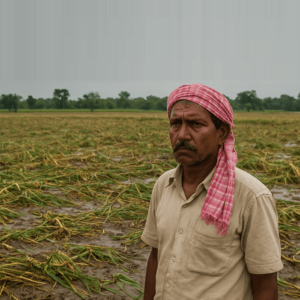Climate Chaos Devastates Farmers: 7 Shocking Ways Extreme Weather Is Rewriting Agriculture
Severe hailstorms and unrelenting rains devastated farms in India’s Jharkhand region in March 2025, erasing months of labor overnight and leaving farmers like Dashmi Devi grappling with ruin. This disaster underscores a grim reality: climate change is turbocharging weather extremes, from droughts to deluges, destabilizing food systems globally. As crops fail from Pennsylvania’s potato fields to Colombia’s corn belts, rising temperatures act as “weather steroids,” amplifying crises.
Yet innovation offers hope: drought-resistant crops, agroecology practices, and AI-driven tools empower farmers to adapt. Systemic gaps persist, though—slow government aid and fragmented policies leave vulnerable communities exposed. Solutions demand collective action: supporting climate-smart agriculture, reducing food waste, and advocating for infrastructure investments.
The crisis in Jharkhand isn’t isolated—it’s a wake-up call. Farmers’ resilience, paired with global cooperation, may yet rewrite this narrative, ensuring fields survive the storms ahead.

Climate Chaos Devastates Farmers: 7 Shocking Ways Extreme Weather Is Rewriting Agriculture
Eastern India’s farming communities are reeling from a cruel twist of nature. In March 2025, hailstorms and torrential rains ravaged Jharkhand’s capital, Ranchi, obliterating months of labor in mere hours. For farmers like Dashmi Devi and Giridhar Mahto, the disaster isn’t just a setback—it’s a stark reminder of how climate volatility is rewriting the rules of agriculture.
The Human Toll: More Than Just Crops Lost
When Devi lamented, “Two-and-a-half months of hard work destroyed in two days,” she echoed a crisis felt globally. Jharkhand, already grappling with droughts since 2022, now faces flooding—a paradox of climate extremes. Mahto’s skepticism about government aid underscores a deeper issue: systemic support gaps. After repeated unfulfilled promises, farmers are left questioning whether resilience is even possible.
Climate Change: The Unseen Culprit
Meteorologists link the storms to warmer Indian Ocean temperatures, accelerating evaporation and monsoon intensity. But this isn’t isolated. From Pennsylvania’s wilting potatoes to Colombia’s stunted corn, erratic weather is destabilizing food systems. As investor Molly Wood notes, rising temperatures act as “steroids for weather,” amplifying disasters. The UN estimates that climate-driven yield declines could push 50 million people into hunger by 2030.
Innovation Amid Crisis: Seeds of Hope
- Climate-Resilient Crops: Scientists are developing drought-tolerant rice and flood-resistant maize. In Bangladesh, farmers now grow submergence-tolerant “scuba rice,” surviving 14-day floods.
- Agroecology: Transitioning to diversified farms—like intercropping legumes with grains—buffers against total loss. Sikkim, India’s first organic state, saw a 66% drop in farm losses post-transition.
- Tech Solutions: AI-powered apps like FarmSense alert growers of impending storms, while satellite data helps insurers expedite payouts.
Systemic Solutions: Bridging the Gap
- Policy Overhaul: Kerala’s disaster compensation model, which uses AI to assess damage within 48 hours, offers a blueprint for timely aid.
- Community Networks: Women-led cooperatives in Maharashtra pool resources to buy weather-indexed crop insurance, reducing reliance on bureaucracy.
- Urban Support: Cities like Bengaluru fund “climate-smart” training programs, linking farmers to direct markets to stabilize incomes.
What You Can Do: From Awareness to Action
- Support Fair-Trade Brands: Companies like Equal Exchange ensure farmers receive premiums for climate-adaptive practices.
- Reduce Food Waste: 30% of global food is wasted—composting or mindful shopping eases pressure on farms.
- Advocate: Push local leaders to invest in rural infrastructure (e.g., rainwater harvesting) and subsidize sustainable tools.
A Path Forward
Jharkhand’s farmers symbolize a crossroads: surrender to climate chaos or adapt with ingenuity. As Devi and Mahto replant, their struggle mirrors a global imperative. The lesson is clear—resilience demands more than disaster relief; it requires reimagining agriculture itself.
“The storm took our crops, but not our hope,” says Devi. In that tenacity lies humanity’s blueprint for survival.
You must be logged in to post a comment.